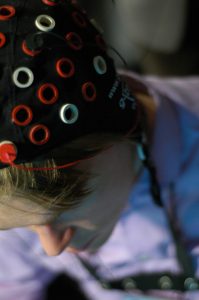Monitoring Brain Tsunamis to Help With Brain Injury
New research is exploring why some brain injury cases recover and others do not, which appears to be linked to what are called brain tsunamis.

Here, a person undergoes a non-invasive scalp EEG. A new study hopes that they can find a way to monitor brain tsunamis with a cap of electrodes. (Flickr / Creative Commons / delta_avi_delta)
These brain tsunamis are seizure-like waves that spread through the brain after a traumatic brain injury. More formally, they are known as “cortical spreading depolarizations.”
The long-term goal of the doctors would be to prevent these so-called brain tsunamis, but the first step is to find a non-invasive way to monitor them.
In a recording of brain waves, there is a cracking noise that indicates normal brain waves, but the periods of silence are caused by the brain tsunamis, which are waves of depolarization that spreads across damaged areas, causing local loss of function. There is an electrical malfunction in the brain.
Spreading across the brain, these waves cause meaningful changes in local brain metabolism, blood flow, oxygenation, and chemistry. After a head injury, these tsunamis can recur over the next few days, causing more severe damage.
Jed Hartings, PhD of the University of Cincinnati College of Medicine was awarded a $4.7 million grant by the Department of Defense to study non-invasive ways to monitor these brain damaging waves, according to WVXU. With his help, scientists have learned that these brain tsunamis contribute to worse outcomes in people who have them.
Scientists may not be able to undo the brain injury, but they can try to halt the secondary damage that comes with it.
The process involves surgically implanting monitoring electrodes directly on the brain (invasive) and a second set on the scalp in the form of a cap (non-invasive).
“We have found in two different groups of patients that there are manifestations of brain tsunamis in the scalp EEG,” Hartings said in our interview with him.
“However, it remains to be determined whether these results generalize to all patients, such as those who do not undergo surgery.”
At the moment, it is still unclear if brain tsunamis can be detected without using invasive methods.
“It also remains to be determined whether the tsunamis can be identified, and with what accuracy, without having the ground truth provided by simultaneous invasive recordings from the surface of the brain,” he said.
“Thus, optimal practice for use of EEG for this purpose remains to be determined in future studies. I believe reliable non-invasive methods will be available someday.”
The scalp EEG would open up monitoring to a much wider variety of patients, brain surgeon Dr. Laura Ngwenya, MD, PhD told WVXU. Once they can find a way to noninvasively monitor these waves, they can look at this phenomenon in the group of people with traumatic brain injuries that do not require surgery.
The research has shown that 60 percent of people with severe traumatic brain injury who require surgery experience these brain tsunamis.
The other universities involved in this research include Baylor College of Medicine, Massachusetts General Hospital/Harvard University, the University of California San Francisco, the University of Pittsburgh and the University of Miami.
After the study, Hartings will need to come up with an algorithm to analyze all of the data.
EEG monitoring could become a standard for all brain trauma intensive care patients and others, like stroke patients, due to the results of this study. Hartings mentioned to WVXU that almost anyone who has suffered a severe stroke has a brain tsunami.